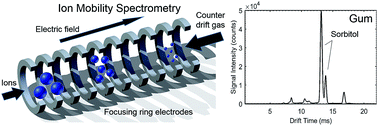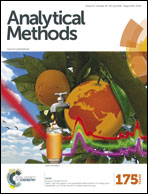Detection and identification of sugar alcohol sweeteners by ion mobility spectrometry†
Abstract
The rapid and sensitive detection of sugar alcohol sweeteners was demonstrated using ion mobility spectrometry (IMS). IMS provides a valuable alternative in sensitivity, cost, and analysis speed between the lengthy gold-standard liquid chromatography-mass spectrometry (LC-MS) technique and rapid point-of-measurement disposable colorimetric sensors, for the Food and Nutrition industry's quality control and other “foodomics” area needs. The IMS response, characteristic signatures, and limits of detection for erythritol, pentaerythritol, xylitol, inositol, sorbitol, mannitol, and maltitol were evaluated using precise inkjet printed samples. IMS system parameters including desorption temperature, scan time, and swipe substrate material were examined and optimized, demonstrating a strong dependence on the physicochemical properties of the respective sugar alcohol. The desorption characteristics of each compound were found to dominate the system response and overall sensitivity. Sensitivities for these compounds ranged from single nanograms to hundreds of picograms with optimal desorption temperatures ranging from 125 °C to 200 °C. Sugar alcohol components of commercial products – chewing gum and a sweetener packet – were detected and identified using IMS. IMS is demonstrated to be an advantageous field deployable instrument, easily operated by non-technical personnel, and enabling sensitive point-of-measurement quality assurance for sugar alcohols.



 Please wait while we load your content...
Please wait while we load your content...